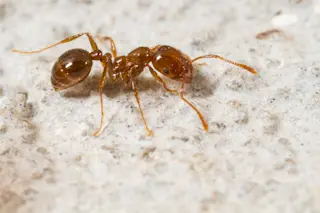Crouched in a weedy Texas field one hot and humid October morning, ecologist Edward LeBrun watched a battle unfold between two aggressive ant species.
A group of tawny crazy ants (Nylanderia fulva), upstart newcomers to the southern United States from South America, was trying to steal food — dead crickets — from hundreds of red imported fire ants (Solenopsis invicta). The red fire ants, also originally from South America but common throughout the southern U.S. for almost a century, have venom so deadly that other ants rarely dare to attack them. “[It] looked like suicide,” says LeBrun.
But LeBrun soon realized the crazy ants had a plan. Whenever they were exposed to fire ant venom, the crazy ants stepped aside to perform an elaborate grooming act. The ants curled up, smearing themselves with a secretion coming from the acidopore, an opening in the abdomen that secretes venom as well as ...















